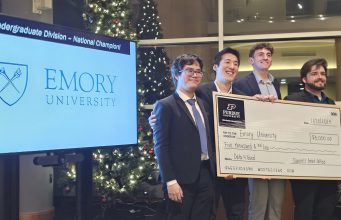
Gary Hauk, vice president and deputy to Emory’s president, arrived on campus as a graduate student in 1983. Five years later while completing his PhD in religion, he accepted a job in the University’s administration, rising to work closely with the board of trustees and four successive presidents (including 1993–94 interim president Billy Frye). In this recent interview with Emory Business, Hauk discusses the contributions of past business school deans in supporting the University’s overarching strategic goals, articulated both in President Jim Laney’s 1987 “Emory 2000” address and in the 2005–15 strategic plan developed under President Jim Wagner’s leadership.
EB: When you joined Emory’s administration, John Robson was dean of the business school. How did his appointment figure into the larger scheme of things at the University?
Hauk: In 1987, the year after Robson’s appointment, President Laney delivered his “Emory 2000” address, which outlined specific targets to guide the development of the University over the next 13 years. Laney listed a number of benchmarks, including doubling federal research grants, graduating 100 first-rate PhD’s every year, and moving the business school into the top 20 nationally. While the school had done well over the previous decades, John Robson’s appointment signaled a determination that this business school needed to play on a bigger stage. Robson had served as a CEO and in several presidential administrations, and he had both a national stature and the opportunity to ratchet things up to a higher plane.
EB: Which of Robson’s initiatives especially helped further the University’s strategic aims?
Hauk: Both Robson and his successor, Ron Frank, were determined to appoint the most eminent faculty they could find, and that was very much consonant with the University’s aims at the time. Jim Laney wanted all of the University’s schools to be competitive with the top schools in their respective cohorts by the year 2000.
Ron picked up that challenge and found ways to connect with the Atlanta business community, and particularly with The Coca-Cola Company, that helped establish the kind of foundation that would push even more vigorously in the direction Jim had outlined. Ron’s relationship with Roberto Goizueta also made it possible for the new buildings to be built—without which it would be hard to imagine the business school being what it is today.
EB: Ron Frank also introduced the Evening MBA program in 1992, which made an Emory MBA available to a wider range of students.
Hauk: Yes, Ron recognized the value of training Atlanta businesspeople for leadership in public affairs. At the University level, Bill Chace was committed to developing that connection to Atlanta and to nurturing city-wide relationships, and what Ron was doing with the Evening MBA fit that very well.
EB: Can you point to pivotal changes over the past thirty years that have aligned the business school more closely with University’s strategic goals?
Hauk: In my mind, the key change has been the development of a much stronger research focus within the business school faculty, which fit the profile of a competitive, national research university that the Laney administration and the trustees sought to develop for Emory. The appointment of faculty committed to doing research and making that a part of their teaching and consultation was also essential to laying the groundwork for launching the PhD program in 2002 under Tom Robertson. The PhD program put the kind of research stamp on the business school that was necessary to meet the ambitions of Jim Laney, and of Bill Chace after him. That research emphasis has become a stronger part of the business school’s identity, and it has helped the school continue to attract top-notch faculty and higher quality students—central components of the University’s 2005 strategic plan.
The other thing I would note—and this is where Tom Robertson, and to some extent Ron Frank, played important roles—was the sense that Emory needed to become an international university. This was a particular emphasis during Bill Chace’s presidency. He worked hard at trying to identify opportunities for strengthening both Emory’s international footprint and the presence of the world at Emory. Chip Parks implemented the business school’s first international student exchange program in the early 1980s, and Ron Frank was open to recruiting and providing necessary funding to a number of international students. President Wagner has really encouraged this development across the University and appointed Tom Robertson in 2004 to spearhead the University-wide effort to find ways Emory could develop internationally.
Larry Benveniste, who served as dean from 2005 to 2013, continued to build Goizueta’s global brand while also working to raise student quality and enhance student experience—another strategic University theme. Part of that enhanced experience is the requirement that BBA students complete two years of liberal arts education before entering the business school, a sequence that Emory believes contributes something important and distinctive to our preparation of business leaders. This requirement is perfectly in keeping with the goal of making the student experience at Emory as rich and strong as possible. The rise in rankings during Larry’s tenure suggests that others are taking note of the quality of our business students’ experience.
Lastly, in addition to the longstanding joint degree programs at the graduate level, the new joint concentrations between the BBA program and the College have furthered closer collaboration between the business school and the University—one of Jim Wagner’s priorities as president. He believes strongly in the notion there is one Emory. We are one institution, and to the extent that the schools foster collaborations and strengthen each other as they strengthen themselves, that is what Emory needs to be doing.







